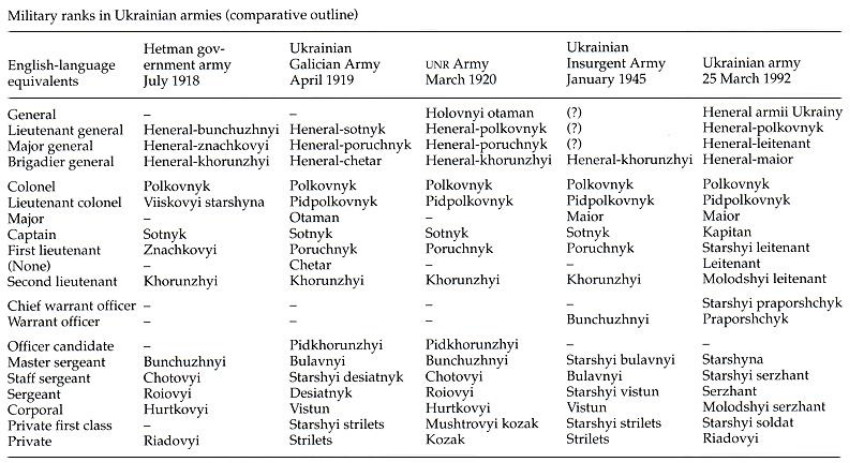Military ranks
Military ranks. Titles conferred upon officers or soldiers to indicate their military qualifications and professional standing. In most modern armies there are five levels of rank: general officer, field grade officer (major to colonel), company grade officer (lieutenant and captain), noncommissioned officer (corporal and sergeant), and soldier (recruit, private, and private first class). Cadets, officer candidates, and warrant officers are usually ranked just below lieutenants.
During the Ukrainian struggle for independence (1917–20) the rank system of the Ukrainian armies changed several times. Under the Central Rada, in January 1918, instead of regular ranks a functional rank system was instituted, in which rank reflected the individual’s position in the organizational structure. The ranks, in ascending order, were kozak (soldier), roiovyi (squad leader), chotovyi (platoon sergeant), bunchuzhnyi (company first sergeant), pidsotennyi (platoon commander or lieutenant), sotnyk (company commander), kurinnyi (battalion commander), polkovnyk (regimental commander), and otaman brygady, dyvizii, korpusu, or armii (brigade, division, corps, or army commander). Theoretically, upon reassignment an individual left his rank with the unit, and his future rank depended on his new position. In July 1918, Hetman Pavlo Skoropadsky established permanent military ranks (see table). After his downfall the Army of the Ukrainian National Republic returned to the functional rank system. It was not until March 1920 that the UNR Army instituted a regular rank system (see table), with rank insignia worn on the collar.
The Ukrainian Galician Army (UHA) had a military rank system from its very beginning. It was formally confirmed in a decree of the secretary of military affairs on 30 April 1919. The rank structure provided for 17 grades (see table), but the highest rank ever attained by an officer (Oleksander Hrekov) was major general. The UHA had relatively strict promotion standards. Given the shortage of officers, it was not unusual for majors or captains to command brigades, and one corps commander started his assignment as a major. Promotions were generally based on merit and service, but in some cases officers were promoted for bravery in combat.
The Ukrainian Insurgent Army (UPA) had a dual rank system. In January 1944 it established a rank system based on functions. There were eight command positions (in descending order): supreme commander, krai commander, group commander, zahin commander, battalion commander, company commander, platoon commander, and squad commander. The appropriate insignia were worn on the right sleeve. At the same time, the UPA routinely appointed and promoted its officers and soldiers to traditional military ranks (see table), for which no insignia were provided. Promotions in the UPA usually followed a period of military service as long as one or two years in a position that required a higher rank. Roman Shukhevych, for example, was promoted to brigadier general only after serving as supreme commander for over two years. Officers and soldiers who had been killed in battle were often promoted to a higher rank posthumously.
Petro Sodol, Zenon Stefaniv
[This article originally appeared in the Encyclopedia of Ukraine, vol. 3 (1993).]
